In May 1994, this article was published in Indianapolis Monthly Magazine. For many years, an online version of the article has been on my website with a label that said “A shorter version of this article appeared in the May 1994 issue of “Indianapolis Monthly” magazine. This is the story as originally written.”
In June 2021, while preparing for a blog post in my Author’s Journal series, I decided to dig out the original article and put up the published version of the story. Upon rereading both versions I was a bit shocked by the differences. The online version must’ve been an early draft and not the version that I ultimately submitted to the magazine. Some of the writing in the online version is terrible and some of the rewrites in the published version sounded like something I had written. I can’t believe that some of the rewritten material was rewritten by the editor.
Click here to read the published version of the story. It contains only one photo that was published with the original article.
Below is the longer version that I had described as “the story as originally written” like it was some sort of director’s cut. But on review I think is better described as an early rough draft 🙂
I have always been a race fan but I never attended the Indianapolis 500 until 1993. For the past 20 years, I’ve spent every free moment in May attending practice and qualifying sessions but I had never been there to witness in person the greatest race in the world. My first 500 came at a time in my life when my days of race fandom were in danger of ending.
I am 38 years old and I have lived in Indianapolis all of my life. The past 35 of those years I’ve lived less than a mile from the number four turn of the Indianapolis Motor Speedway. My family and I have always been race fans. One of my earliest childhood memories is of a visit to the track for qualifying one day when I was about six years old. While growing up I had many other visits. As an adult, I’ve made my daily visits to the track in May a top priority in my life. Yet the Memorial Day event was always spent listening to the race on the radio.
The main reason I had never attended the 500 is that until this year there was no acceptable place to sit. I know that over 400,000 other people watch the race with no complaints. Why am I so picky? I’m not picky — I’m handicapped.

My first trip to the Speedway when I was six years old. My dad sitting next to me. The grandstand had wooden folding chairs. He carried me and my wheelchair up a few rows, removed one of the chairs and set me there in my little wheelchair.
In my early years as a fan, there were only two poor options for wheelchair seating. One was the infield grass areas complete with drunks and near-naked women. While the so-called “Snake Pit” had its appeal, it was a dangerous, crowded place on race day with a marginal view of the track. Another option was a wooden bleacher on the inside main straight, north of the Tower Terrace. This Terrace Extension had ramps to a raised platform in front of the stand. While this was acceptable for practice or qualifying, a wheelchair would have been a dangerous obstruction on the very narrow walkway with a full race day crowd.
The Terrace Extension was replaced about 4-5 years ago with a new grandstand topped with suites. That same year a new wheelchair section was built inside the track just before turn two. This new wheelchair seating facility is undoubtedly one of the finest I’ve ever seen. Unfortunately, it is in a rather poor location. An infield short chute position has a very limited field of view. This limited view is further diminished because my handicap has left me with a very stiff neck. My head will not turn left or right very far. On practice or qualifying days, I can occupy two wheelchair spaces and turn my entire wheelchair to get a better view. On race day I would have to purchase two seats just for myself.
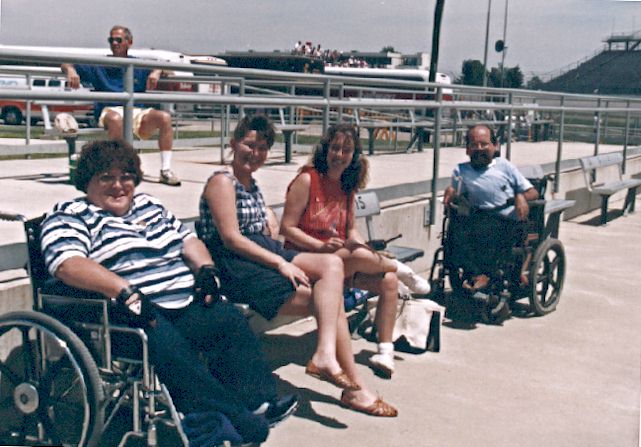
The south chute wheelchair grandstand is a good place to sit on practice and qualifying days. Here left-to-right is my cousin Nancy, sisters Karen and Carol and myself enjoying a day at the track.
With the announcement that NASCAR was bringing Winston Cup racing to the Speedway with the Brickyard 400, I could no longer resist the pull to actually see a race in person. I decided to take my chances in the wheelchair area despite my limited head movement. If the view was unacceptable then I’d consider requesting two seats the following year so that I could sit sideways. Seeing a race in person had become such a priority that I was willing to pay double if I had to do so.
It was early in May 1993 when I decided to apply for tickets. I was sure that the 1993 race had to be sold out. I decided that I would apply for ’94 tickets after the race.
Meanwhile, I planned for my usual May activities of attending practice and qualifying every free moment. Because I am self-employed at home as a computer consultant and writer, I can plan to take plenty of time off to feed my hunger for being near the high-tech wheelchairs called Indy Cars.
Most of the time, I spend my day at the track cruising around Gasoline Alley in my motorized wheelchair. I’m quite recognizable as the guy with a bald head, beard and a video camera mounted on my chair. I’ve been told that my 20 years of cruising the garages have made me a “fixture” there. The garages are not only appealing because of the limited wheelchair seating, I really enjoy being close to the crews who tinker with millions of dollars worth of equipment in a gamble to be the best.
I am a bit of a gambler and tinkerer on a much smaller scale. One year I spent $80 on an electronic stopwatch even though I knew it was useless to me. The gamble was that I could adapt it so that I could work it. My Dad disassembled the watch. Under my direction, he soldered in new easy-to-push buttons that I could work myself. The biggest such gamble was my $700 video camera that we adapted with new controls and a feather balance camera mount. That bit of gadgetry caught the attention of chief mechanic Peter Parrot one year as he was working on Rick Mears’ car in the Penske garages. He complimented me on the clever job I’d done.
I told him “I just like buying high-tech toys and then betting that I can make them do what I want them to do.”
“Hmmm that sounds like my job description” he laughed. “But in my case, it’s Roger [Penske] who loses money when I’m wrong.”
Perhaps Gasoline Alley was such fun for me because it is the home of such high-tech tinkerers as Team Penske. Roger is the most determined and competitive man in racing today. If I have a favorite driver in any year, he’s probably a Penske employee. From his early drivers Mark Donahue, through Mario Andretti, Danny Sullivan, Rick Mears, Emerson Fittipaldi, and now Paul Tracy, Penske has shown that he knows it takes the smartest drivers and the newest cars to win races. He spares no expense to acquire both.
Unfortunately, it seemed that my garage fun was about to end. My muscular dystrophy leaves me a tiny bit weaker every year. Maneuvering my wheelchair over bumpy pavement, in a crowd, in the hot sun or cold wind, while trying to operate a video camera is at the very limit of my ability. I needed to prepare myself for the possibility that I wasn’t going to be able to get around on my own. I might be spending the month in the handicapped section just watching. My special stopwatch had lost its appeal and the video wouldn’t be as much fun in the stands. I needed a new high-tech toy to play with while sitting in the grandstand.
The perfect solution was a scanner radio for monitoring conversations between the crews and the drivers. After doing some research I discovered that the Frequency Fan Club offers an excellent deal on a 200 channel 800 Mhz model and they throw in a subscription to their newsletter containing up-to-date lists of frequencies. Other information on where to tune and what to listen for could be found on CompuServe’s Racing Information Service. Unfortunately, I had ordered my radio a bit late and it would not arrive until the end of the first week of practice. That would give me time to try the video in the garage area one more time.
The first week of May, my mother went over to the Speedway to pick up our season gate passes and garage badges. Mom is a great race fan too and she enjoys sitting in the stands watching cars while I’m in the garages. At the ticket counter, she was somehow inspired to ask a silly question. “You wouldn’t have any leftover handicapped seats this year would you?” It’s common knowledge that the race sells out months in advance. To our great amazement, they said “Yes, how many do you need?”
Among the many changes at the track for 1993 was a new grandstand with a new wheelchair seating area. Seats were still available because the wheelchair area was too new to be listed in the ticket order forms for the ’93 race. All sales had been over-the-counter and the only publicity was word-of-mouth.
This dream-come-true was even better than I had imagined because the new wheelchair seats were outside the track. The North Vista Wheelchair Platform is a raised platform in front of the new North Vista grandstand that runs all of the way from turn three to turn four. I believed that an outside location would offer a better view for my limited head movement than the wheelchair area inside the South Chute.
We came back the next day with the necessary cash to buy one wheelchair seat and two companion seats for Mom and Dad to go with me. I participated in some word-of-mouth publicity and my wheelchair-bound cousin Nancy picked up the last three tickets available.
I was going to the race THIS YEAR!
The whole family was excited. All my life I’d heard my parents tell stories of the fun times they had had going to the race when they were younger. However, Dad hadn’t been to the race since his high school days and Mom’s last visit to the 500 was in the early ’60s.
Unfortunately one of her favorite drivers, Eddie Sachs was killed in a fiery crash the last time she was there. I had strange memories of that race as well. As I mentioned earlier, I live near the 4th turn. I could see the column of black smoke from our back yard.
I’ve never actually seen a human being die. I hope I never do. Yet I had to prepare myself for the possibility that I might witness some terrible tragedy. Several years ago on a qualifying day, I sat at the entrance to turn three and saw Gordon Smiley drive by me just seconds before his fatal impact into the North Chute wall. All I saw was a cloud of debris and fire just behind the infield bleachers that blocked my view of his impact. The 1992 race also weighed heavy on my mind as it was 200 laps of misfortune that left five drivers hospitalized. I don’t want there to be more wheelchair-bound drivers in Gasoline Alley — only fans like me.
Family commitments kept me from the first two days of practice but Monday, May 10th I was there full of anticipation and excitement. Mom and I arrived about noon and we had a quick bite of lunch at the snack bar next to the museum. A quick tour of the gift shop revealed the usual assortment of overpriced trinkets that we managed to live without. Finally, it was on to the main straight and the entrance to Gasoline Alley.
Mom always sits in the stands just south of the garage entrance so I know where to find her if I need her. I tour the garages with the month-long goal of getting one good video shot of every car that qualifies. At a pre-arranged time and location I meet Mom behind the stands so she can make sure I’m ok. I generally drink a Coke, rest in the shade and do some girl watching before going back to the garages. We check in with each other about once every hour and then head for home about 4 or 5 pm depending on how tired and sunburnt we are by then. Sometimes we stop by the handicapped section so I can see the mechanical beasts actually run.
The first day was a disappointing mess. My first tour of the garages went well but there was a minor problem with the camera that left me with no video. At the designated time I went to meet Mom. I seemed to have more difficulty than usual driving over the bumpy patches of asphalt behind the grandstand. I made it to the right spot and Mom arrived with a Coke for me. We diagnosed and fixed the camera problem and I took off again for the garages.
No sooner was Mom out of sight than I hit a bump too hard and I slumped forward. My hand slipped off the wheelchair control and I was stuck. I’ll spare you the details but I eventually needed the help of three different Good Samaritans that day. I gave up and returned to my meeting spot behind the stands. When Mom showed up, I told her what happened and I decided I wanted to go home.
Monday evening I sat at home in silent frustration and disappointment. It looked like I no longer had the ability to get around on my own in a hostile environment. After a suitable amount of sulking, I went to work plotting a new strategy. Perhaps it was time to consider converting my wheelchair from hand controls to mouth controls. I want to delay that step until I have lost all use of my arms. I have few problems driving my chair on smooth ground. It was the bumpy pavement that was my downfall. However, Gasoline Alley itself has smooth concrete. If I could get in and out of the garage area ok then I was sure I’d be back in business.
After some discussions with Mom, we changed our routine for Tuesday. Mom escorted me into Gasoline Alley. A new relaxed dress code in the garage area that now permits short pants meant she could still dress comfortably and could work on her suntan. She would leave me there on the smooth pavement that I could handle. We would still periodically meet but it would be inside Gasoline Alley. At the end of the day, she would escort me out. In the days that followed, the new arrangement worked beautifully. I shot some great video and enjoyed every minute of it.
Late in the first week of practice my new scanner radio arrived. Some days I spent more time in the wheelchair area watching cars run while listening to the radio than I did shooting video in the garage. The radio is WONDERFUL!
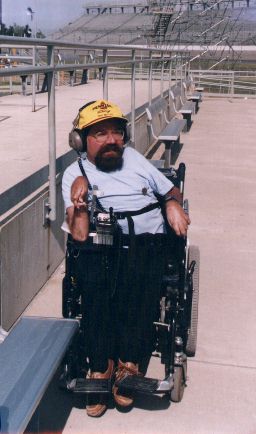
Here I sit in the south chute wheelchair grandstand on a practice day. I’ve got my Penzoil hat on that was a gift from Team Penske a few years prior when Penzoil sponsored Rick Mears’ Indy 500 winner in a Penske machine. The headphones fit nicely over the hat and keep it from blowing off.
During practice, the drivers don’t talk as much as on race day. They talk most while sitting still in the pits. It’s easier to just stay strapped in the car and to talk on the radio than to take the helmet off to talk to the crew. I really liked listening to the drivers complain about the problems and the crew chiefs suggesting solutions. The recently retired A.J. Foyt spent lots of time on the radio talking to his protege Robby Gordon. It was great hearing the most experienced driver at Indy coaching this new kid.
I was surprised to discover that the race officials are almost as interesting as the drivers. Periodically they shut down the track for 5-10 minutes for “Track Inspection” or to pick up debris off the track. I never knew exactly how they decided when it was time to do this.
Now I know. Obviously, if a track observer spots something on the track he reports it and the yellow light is turned on to close the track. But there is another way that the track can be closed. Typically a car will come into the pits and the crew checks the car and makes adjustments. Among the tasks is to check the tires. If the crew discovers a cut or gash in a tire they report it to a nearby USAC official. He tells USAC control and they shut down the track. The safety trucks roll out and they look for debris. There are also USAC observers stationed around the track who watch for debris and they walk around the track near their post during such inspections. They pick up the debris and report what they found, where it was, and if it looked like it had been run over. The part is taken back to the pits. Usually, it’s a simple nut or bolt. Sometimes it’s a small piece of carbon fiber bodywork from a car.
The remaining practice days I spent the day doing a variety of picture taking and radio monitoring while counting the minutes until race day and praying for no rain. Some of the people who helped me that first day happened to see me later in the month. They asked if I was ok. Race fans are special people.
I was only able to make it to one day of qualifying but I did see Arie Luyendyk take the pole from Mario and I waved goodbye to A.J. Foyt as he took his last lap at Indianapolis. I watched the “Bubble Day” coverage on ESPN and was sad to see series champion Bobby Rahal bumped from the field and miss the race. Rahal was quite gracious in his acceptance of his mistakes and he promised to return next year much wiser for the experience.
The night before the race I felt like a kid on Christmas Eve. Somehow I managed to sleep a reasonable number of hours. When I woke up I joked with my parents “Did Santa come last night and make it become race day?”
It didn’t take long to pack everything in the van. Give my Mom a month to plan for an event and she’ll have the logistics and supplies ready sufficient to invade a small country. Dad shook his head in amazement “Gee the race only lasts 3 hours. This looks like a week’s vacation!”
“If we spend all day in the van waiting on the rain you’ll be glad I brought all of this stuff” she replied.
Considering that some folks spend hours in traffic jams trying to get to the race it seemed almost sinful that we took only 10 minutes to get there. A special window sticker is given to all handicapped ticket buyers. We drove right by the long lines trying to park in the Coke plant lot and we were directed to a reserved area near the grandstand.
I’d seen enough pictures of the hundreds of thousands of faces in the stands to know what that would look like. However, I was unprepared for the sight of the incredible moving mass of humanity walking into the track in a stream that looked like the early stages of a slow-moving marathon. This river of humanity turned into a turbulent disorganized swarm around the grandstands as yellow-shirted safety patrol workers tried to direct people to the proper place.
We parked quite close to our assigned seats in Section 22 very near the entrance to the 4th turn. Upon reaching the grandstand we encountered a well-designed wheelchair ramp with level places every 30 feet to allow you to rest if needed. We presented our tickets to the patrolman and he pointed to a spot right in front of the ramp. We were finally there!
When I saw where “there” was my heart sank. The wheelchair seat was at the front of the platform up against the railing. The concrete retaining wall and steel fence were about 10 feet in front of me. I had no idea that I would be so incredibly close. I nearly cried at the thought that I would be spending the next 3 hours staring stiff-necked at a few feet of track as 200 mph blurs unintelligibly sped by me.
Dad pushed my chair into the tight space assigned to me and I tried looking to my right. My head barely moves that way. I could see but a few feet into the turn. Then I turned my head left. My normal comfortable sitting position is to look slightly to the left and my head will turn farther that way. It was only then that I realized that I was sitting a short distance into the turn. The North Chute was not directly to my left. It was angled away from me slightly. Before me stretched a breathtaking view. I could see the last half of the third turn, all of the short straight and the entrance of turn four in front of me.
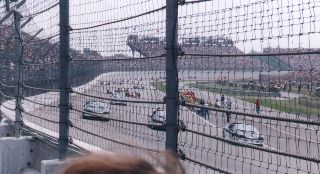
This parade lap photo shows exactly what I saw the entire race as I turned my head left. My normal comfortable sitting position is to look slightly to the left and my head will turn farther that way. I was sitting a short distance into the turn. The North Chute was not directly to my left. It was angled away from me slightly. Before me stretched a breathtaking view. I could see the last half of the third turn, all of the short straight and the entrance of turn four in front of me.
The location was perfect. The view was perfect. The weather was perfect and I was there to see my first live in-person Indy 500.
All of the traditional pre-race festivities began about 10 am as Mom helped me jot down some last-minute scanner frequencies that were broadcast by the Frequency Fan Club. A parade of celebrities drove by in pace cars and waved. I had a great fence-hugging view of them.

Here actor Eric Braeden speeds by in a pace car during pre-race festivities. He played a computer science genius Dr. Forbin in one of my favorite cheesy sci-fi thrillers Colossus: The Forbin Project and he played the German Field Marshall Captain n the ’60s TV series The Rat Patrol.
He is however more widely known as the rich and powerful Victor Newman in the soap opera The Young and the Restless. (Which I’m embarrassed to say, I watch every day.) But part of me still thinks of him as Dr. Forbin.
Click here for a humorous story about that photo.
At 10:45 Archbishop Buechlein offered an invocation prayer. While I deeply miss the late Archbishop O’Meara, my new spiritual leader did an excellent job setting a Memorial Weekend mood. He reminded all that this was the Christian feast of Pentecost when the Holy Spirit descended upon the Apostles. As he invoked the Spirit to protect us all and gave thanks for the blessing of the day, I reflected on the blessings that had brought me there: my parents who have worked so hard to give me every opportunity to enjoy life; the technology that makes it possible for someone of my limited ability to pursue hobbies like videography; the foresight of the Speedway management that sees wheelchair access to a variety of locations as an integral part of their renovations; the strangers I encountered who helped me on a bad first day of practice; the divine providence that led me to buy tickets in exactly the right spot for my special needs; these blessings and more occupied my mind as the prayer concluded.
From the sounds of “Taps” to a roaring F-16 flyby to “Back Home Again in Indiana” to “Lady and Gentlemen, Start Your Engines” the festivities continued. Soon the parade lap led by three pace cars rolled into view out of turn three and headed towards me. As the cars rolled by a stiff breeze blew a wave of exhaust in my face. I chuckled to myself as I paraphrased Robert Duval in “Apocalypse Now” when I noted that the smell of methanol fumes smelled like Victory!
The next sight was a lone pace car speeding out of turn three. Far behind it came the near-perfect rows of three abreast led by Arie Luyendyk, Mario Andretti, and Raul Boesel. The field rocketed by and Tom Carnegie announced that the green flag was out! The race was on!

Brazilian Raul Boesel enters the 4th turn on lap 1 of the 1993 Indy 500. Right behind him is former winners Arie Luyendyk and Mario Andretti.
Raul Boesel appeared in the lead as the field came towards us from turn three and a large contingent of fans from Brazil in the stands behind me cheered and chanted their approval in unison. Over the first few laps, his lead widened until Jim Crawford spun in turn two. Moments later Crawford drove by in the warm-up (or is it slow down?) lane in turn four. Smoke trailed from his car and the wind delivered a new scent across the track moments later.
As I listened to Frenchman Stephan Gregoire speaking his native tongue on the scanner radio I wished I had studied harder in high school and college French class. My D+ average was no use to me today.
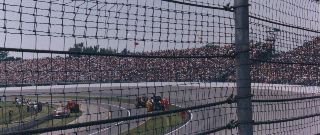
“Norm Hall Hit the Wall”
Actually its Danny Sullivan whose car rolled to a stop in this photo. But it reminded me of the first time I saw a damaged race car. It was my first trip to the track as a small child. Driver Norm Hall hit the wall in the first turn while qualifying. I couldn’t see it but it sounded like fun and I began singing “Norm Hall hit the wall. Norm Hall hit the wall.” My Dad explained that this was no laughing matter. He later took me by Gasoline Alley where I could look through the fence and see Hall’s damaged car. I got the point.
Sullivan’s wreck was the first wall contact I’d ever seen in person. He injured his leg as a suspension piece penetrated the foot box but it was not a serious injury.
A few laps into the race I saw a large puff of white smoke erupt from a dark blue car as it bounced off the outside wall just out of turn three. Although I have seen cars spin before, I had never seen an actual impact in person. As the car rolled by me with a badly mangled right front suspension I could see it was #7, Danny Sullivan. He rolled to a stop too far in to turn four for my stiff neck but Mom reported that he had climbed out. She snapped a photo as the safety vehicles towed the car away.
I recalled the first time I saw a damaged race car. It was my first trip to the track as a small child. Driver Norm Hall hit the wall in the first turn while qualifying. I couldn’t see it but it sounded like fun and I began singing “Norm Hall hit the wall. Norm Hall hit the wall.” My Dad explained that this was no laughing matter. He later took me by Gasoline Alley where I could look through the fence and see Hall’s damaged car. I got the point.
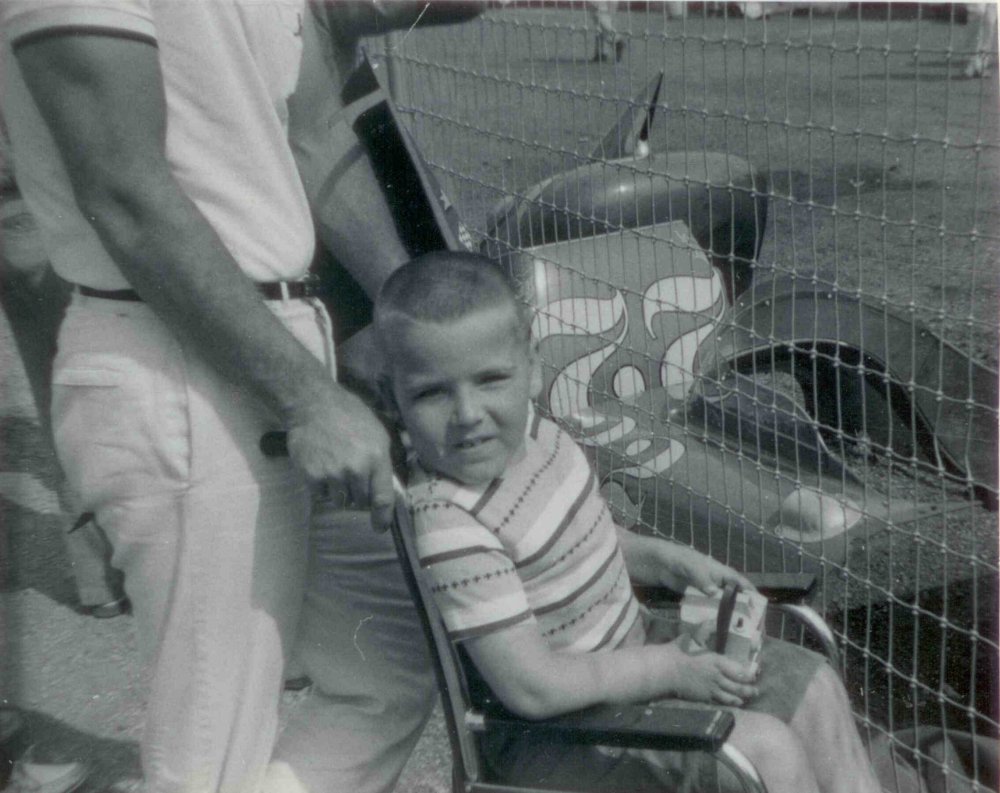
Me at the fence of Gasoline Alley at age 6. Those car parts behind me were not the debris from the Norm Hall wreck but I could see the wrecked car in one of the garages near there.
Mario soon took the lead and I knew of one race fan who was ecstatic. My cousin Nancy was sitting about 8 wheelchair seats to my left and was cheering her hero onwards as she witnessed her first 500 too. Nancy has been a lifelong fan and like me, she spends what time she can at the track. Mario has been quite kind to her over the years. He knows what a devoted supporter she is and he always has time to give her a hug, a kiss, and to pose for a picture.
Eventually, Nigel Mansell worked his way to the lead but the leaders reshuffled after pit stops. I’ve been quite impressed with Mansell’s humility all month. As defending World Driving Champion he could have flaunted his expertise and taken offense at the word “rookie” being applied to him. He did not. Mansell is not arrogant about his stature in the racing world. He knows that Indy is a whole new game for him. He isn’t intimidated by the challenge of Indy but he has respect for his own limitations that helps him maintain a realistic perspective. I listened to him on the scanner while watching his skill on the track. I think I’ve become a big Nigel Mansell fan.
Later on, I witnessed the best-kept secret at the track. Jim Crawford spun without hitting anything again but this time he was in full view of the north-end fans like myself. He recovered right in front of me and continued into the pits but the track announcers never reported the spin. The radio was busy as confused pit crews tried to figure out why there was a yellow light. The drivers reported in that they saw nothing on the track.
During this yellow light, Mansell missed his pit and cursed himself in frustration on the radio. The crew pushed him into the proper pit and serviced the car while the crew chief tried to reassure Nigel that it won’t hurt much. He was concerned he would get a penalty but the crew reassured him he wouldn’t. The stop was completed while still under yellow and Nigel remained in the lead lap but dropped to 7th place.
An orange and white Marlboro car slid into view against the 3rd turn wall and I held my breath to see if it was Tracy or Fittipaldi. In either case, it was a sad sight to this Penske fan. Tracy climbed out apparently uninjured and I breathed easier.
It seemed like the race had just started yet I noticed that the halfway mark had already passed. In the quiet moments when the field is on the far end of the track moving slowly under caution, there is time to relax, talk, and grab a bite of lunch. Lap after lap under green is an assault on all of one’s senses when sitting that close to the track. The noise is felt as much as it is heard. I was beginning to notice a fine layer of grit accumulating on my skin. My eyeglasses were dirty and I had a strange oily taste in my mouth. I wasn’t just seeing the race I was being immersed in it.
I loaned my scanner headphones to Mom, Dad, and Nancy for a few laps each. They enjoyed listening but were nice enough to give them back as a dual for 2nd place developed between Mansell and Al Jr. However the radio was quietest during such intense moments as drivers need their full concentration to race.
Suddenly two cars slid into view through turn three at odd angles then ricocheted off of each other and the outside wall. They came to a rest in the straight as cars dodged debris that scattered everywhere. Rescue teams arrived in seconds and risked their lives as cars weaved in and out trying to avoid puncturing a tire.
Television usually focuses on a close-up of drivers climbing from the cars at this point. Naturally, that is the most important issue. However, the broader view I had of orange-clad course workers directing traffic and trying to clear debris was an unexpected thrill. It takes time for cars to slow down and pick their way through the chaos. I always admired the rescue workers who attended to the drivers. Now I have a deeper appreciation of those who take care of other peripheral yet vital tasks at such times. Jeff Andretti and Roberto Guerrero climbed out. Guerrero ended up with bruises. Jeff was ok.
The green returned with Mario in 2nd in an Al Unser sandwich. Junior was in first and Senior was close behind in 3rd. I didn’t know who to cheer for as ten of my favorite drivers were still in great shape to win. Only 6 cars had dropped out and the race was 3/4ths over. Mario took the lead but others were close behind.
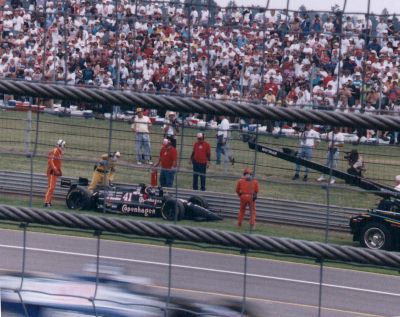
Robbie Gordon Gets the Hook!
It had been fun all month listening to the recently retired A.J. Foyt in his new role as car owner as he spent lots of time on the radio talking to his protege Robby Gordon. It was great hearing the most experienced driver at Indy coaching this new kid who has shown lots of promise. Unfortunately, it was not a good day for car owner A.J. Foyt as Robby Gordon blew an engine in car #41 and rolled to a stop directly in front of me.
The radio was abuzz with the strategy for the final pit stops. Robby Gordon blew an engine and rolled to a stop directly in front of me. A flurry of pit stops reshuffled the leaders yet again. Mansell recovered from his pit mistake and lead the race as I heard Lyn St.James report mechanical trouble. She rolled by slowly and the yellow winked on.
With little or no fanfare Emerson Fittipaldi suddenly was in 2nd with Arie right behind. I heard the Penske crew warn Emmo to watch for Arie on the restart. I should have known something was up Emmo’s sleeves. The green flashed on and an unaware Mansell dropped to 3rd place by the time he reached the first turn. Emmo and Arie had zoomed by him.
While the hundreds of thousands cheered Emmo, Arie and Nigel onward, I sat in shock as I heard USAC reports that all three had passed under the yellow. I couldn’t believe that a last-minute stop-and-go penalty might hand the race to Boesel who was in fourth place. Boesel had had two penalties earlier but had fought his way back to the front. As I awaited further word on penalties, the radio blared with a familiar British voice “I’ve hit the wall in two!” I thought my radio display said car #91 but it must have been cross-talk from a nearby frequency because it was obviously Mansell. Somehow Nigel continued on to finish third. The penalties to the leaders never materialized. Arie finished second with Mansell and Boesel not far behind.
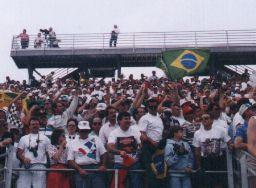
A contingent of fans from Brazil sitting behind me waving Brazilian flags cheered as their countrymen Emerson Fittipaldi wins his second Indianapolis 500.
My hero the high-tech tinkerer, car owner Roger Penske had won his 9th Indy 500 race in 25 years as a car owner. The Brazilian contingent behind me sang and cheered their approval as their countryman Fittipaldi took a victory lap. Everyone else stood and applauded the entire field for putting on the most competitive race in years with 24 cars still running, 10 on the lead lap, and under 10 seconds between first and eighth place. I was hot, dirty, tired, and fulfilled. It was an experience I’ll never forget.
The trip home was another journey through an unbelievable mass of people. Upon arriving home I turned on my computer and began composing this reflection. As I wrote through the next day, pausing only to fill out my application for tickets to next year’s race, I began to understand why I am a race fan. It’s more than affection for technology or the thrills of speed or the quest for victory. It’s the struggle itself that appeals to me.
At the awards ceremony the day after the race my heroes like Mansell and St.James spoke with true humility about what a privilege it is just to be allowed to participate. As a disabled person, I understand that sometimes simply participating is its own reward.
Furthermore, we can all identify with people like Rahal whose poor planning cost him a chance to run. Yet like Rahal, we have to put it behind us and move on.
We’ve all made mistakes through inexperience like Mansell’s missed pit or his slow restart. Yet like Mansell, we must learn from those mistakes and understand that there is always room to grow no matter what great achievements we have earned in the past.
We’ve all had days like Raul Boesel had where it seemed that the rules weren’t clear or weren’t enforced fairly and we were left as victims. Yet the next day at the awards ceremony Boesel said that he had put aside his pain, anger, and sadness and concluded that he was proud that he had done his best. Other drivers like the two Unsers, three Andrettis, Scotts Brayton, and Goodyear took similar pride that they had done their best.
My month of May had its ups and downs but in the end, my best efforts and the grace of God made it a wonderful experience. The men and women who come to Indianapolis each May all want to win the race but they are all heroes from first to last because their racing exemplifies the struggles of life.
Life isn’t about winning. It is about racing. It’s about doing your best against the odds and discovering the rewards of participation itself. It’s about bouncing back when things go wrong and constantly growing no matter how much you have already accomplished.
That’s why I’m a race fan.



